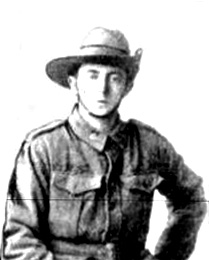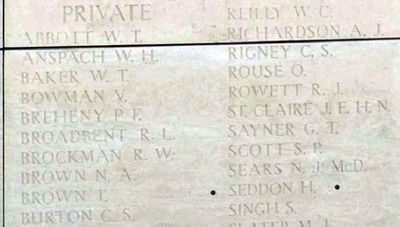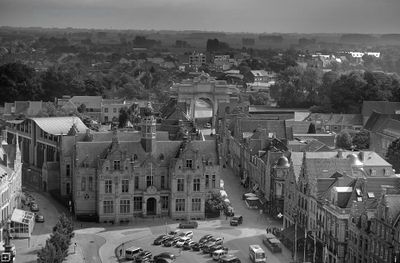Difference between revisions of "Henry Seddon"
From Our Contribution
(→Notes) |
|||
| (10 intermediate revisions by 2 users not shown) | |||
| Line 1: | Line 1: | ||
| − | {{ | + | {{infobox soldier |
| − | | | + | | image = [[File:Seddon_Henry.jpg|border|400px]] |
| − | + | | caption = Western Mail 9 Nov 1917 page 2 S | |
| − | + | | image2 = | |
| − | + | | caption2 = | |
| − | + | | dateofbirth = c1892 | |
| − | + | | placeofbirth = Higer Openshaw, Manchester, England | |
| − | + | | death = 4 Oct 1917 | |
| − | + | | placeofdeath = Broodseinde, Belgium | |
| − | | caption | + | | enlistmentage = 23 years, 10 months |
| − | | | + | | description = 5'2" (1.57m) tall; weight 118 lbs (53.5kg); fresh complexion, grey eyes, dark brown hair. |
| − | | caption2 | + | | height = 5'2" (1.57m) |
| − | + | | weight = 118 lbs | |
| − | + | | complexion = fresh | |
| − | + | | eyes = grey | |
| − | + | | hair = dark brown | |
| − | + | | descriptionnote = | |
| − | + | | occupation = Railway Porter | |
| − | + | | religion = Methodist | |
| − | + | | address = | |
| − | | | + | | relation = Father |
| − | + | | nextofkin = Mr William Seddon | |
| − | + | | regnumber = [ 2627] | |
| − | | | + | | enlistmentdate = 21 Aug 1916 |
| − | + | | rank = Private | |
| − | | | + | | unit = 43rd Battalion, 5th Reinforcement /11th Brigade, 3rd Division |
| − | + | | embarkationdatefrom = 9 Nov 1916 | |
| − | + | | embarkationdateto = 10 Jan 1917 | |
| − | + | | shipembarked = [[HMAT A8 Argyllshire]] | |
| − | | | + | | dateofreturnfrom = |
| − | + | | dateofreturnto = | |
| − | + | | shipreturned = | |
| − | | | + | | shipreturnednote = |
| − | + | | dateofreturnfrom2 = | |
| − | + | | dateofreturnto2 = | |
| − | | | + | | shipreturned2 = |
| − | + | | shipreturnednote2 = | |
| − | | | + | | fate1 = Killed in Action 4 Oct 1917, Broodseinde, Belgium |
| − | | | + | | fate2 = |
| − | + | | fate3 = | |
| − | | | + | | fate4 = |
| − | | | + | | monument1 = [[Mundijong Honour Roll]] |
| − | + | | monumentnote1 = | |
| − | | | + | | monument2 = [[Menin Gate Memorial]] |
| − | | | + | | monumentnote2 = |
| − | + | | monument3 = [[ANZAC Memorial Park (Byford)]] | |
| − | | | + | | monumentnote3 = |
| − | | | + | | monument4 = [[Gosnells Road Board Honour Roll]] |
| − | + | | monumentnote4 = | |
| − | | | + | | monument5 = [[Gosnells War Memorial]] |
| − | + | | monumentnote5 = | |
| − | | | + | | monument6 = [[Gosnells Primary School Honour Roll]] |
| − | | | + | | monumentnote6 = |
| − | + | | monument7 = Gosnells Ward Honour Roll | |
| − | | | + | | monument7note = |
| − | | | + | | monumentawm = [https://www.awm.gov.au/collection/R1662942 Australian War Memorial] |
| − | + | | monumentawmnote = | |
| − | | | + | | monumentother = |
| − | | | + | | monumentothernote = |
| − | + | | medal1 = [[British War Medal]] | |
| − | | | + | | medal2 = [[Victory Medal]] |
| − | | | + | | medal3 = |
| − | + | | medal4 = | |
| − | | | + | }} |
| − | | | ||
| − | |||
| − | |||
| − | |||
| − | |||
| − | |||
| − | |||
| − | |||
| − | |||
| − | |||
| − | |||
| − | |||
| − | |||
| − | |||
| − | |||
| − | |||
| − | |||
| − | |||
| − | |||
| − | |||
==Pre War== | ==Pre War== | ||
| − | + | In 1904, Henry and two of his siblings Edith and Winifred accompanied their parents in migrating to Australia on the SS Ophir. | |
==War Service== | ==War Service== | ||
| − | Three weeks after commencing his training Henry was allocated to the 7th reinforcement draft for the 48th Battalion, but a week later this changed to become the 5th draft for the 43rd Battalion. | + | Three weeks after commencing his training Henry was allocated to the 7th reinforcement draft for the 48th Battalion, but a week later this changed to become the 5th draft for the 43rd Battalion. Soon after enlisting Henry caught influenza and spent 5 days in the camp hospital. |
| − | Arriving in England, Henry was sent to the 13th Training Battalion at Durrington to prepare for the Western Front. | + | Arriving in England, Henry was sent to the [[13th Training Battalion]] at Durrington to prepare for the Western Front. |
| − | On 25 Apr 1917 Henry proceeded overseas to France through Folkestone, and entered the 3rd Division's Base Depot in Étaples. On 1 May 1917 Henry was taken on strength by the 43rd Battalion, who at that time were engaged in a 4 day route march from Armentiers to Jurnay. Henry would have participated in the last three days of it. | + | On 25 Apr 1917 Henry proceeded overseas to France through Folkestone, and entered the 3rd Division's Base Depot in Étaples. On 1 May 1917 Henry was taken on strength by the [[43rd Battalion]], who at that time were engaged in a 4 day route march from Armentiers to Jurnay. Henry would have participated in the last three days of it. |
At what was to become known as the Battle for Broodseinde Ridge, the 45th Battalion was tasked with taking and holding the first line of objectives, and it did this with success. The attack to capture the village of Broodseinde began before dawn on the 4th of October 1917. It was a large operation, involving twelve divisions, which included British, Australian and a New Zealand Divisions attacking along a 10 kilometre front. In the centre was I and II Anzac Corps, composed of three Australian divisions and the New Zealand Division. | At what was to become known as the Battle for Broodseinde Ridge, the 45th Battalion was tasked with taking and holding the first line of objectives, and it did this with success. The attack to capture the village of Broodseinde began before dawn on the 4th of October 1917. It was a large operation, involving twelve divisions, which included British, Australian and a New Zealand Divisions attacking along a 10 kilometre front. In the centre was I and II Anzac Corps, composed of three Australian divisions and the New Zealand Division. | ||
| − | Before the attack began, | + | Before the attack began, one in every seven of the Australians soldiers involved became casualties through heavily enemy shelling. The Germans had also launched an attack of their own and the Australians were confronted with enemy troops coming towards them. Our soldiers proceeded on through the German assault waves and gained all their objectives along the ridge. The cost was heavy with the enemy's pillboxes difficult to overcome. However, the 43rd Battalion's casualties, which included Henry for a day's work were 37 killed in action, and 104 wounded. |
Red Cross file: <ref>{{cite web |url=https://www.awm.gov.au/collection/RCDIG1049978 |title=Australian Red Cross Wounded and Missing Files - Henry Seddon |author=<!--Not stated--> |date= 2018|website=Australian War Memorial |access-date=2 May 2018}}</ref>. <blockquote>" At Passchendaele Ridge I was wounded the same day as Seddon. He was at the 1st Dressing Station with me and his wound was not one that I should have thought very serious. I do not know what became of him." '''Mowbray W. Pte 1878''' | Red Cross file: <ref>{{cite web |url=https://www.awm.gov.au/collection/RCDIG1049978 |title=Australian Red Cross Wounded and Missing Files - Henry Seddon |author=<!--Not stated--> |date= 2018|website=Australian War Memorial |access-date=2 May 2018}}</ref>. <blockquote>" At Passchendaele Ridge I was wounded the same day as Seddon. He was at the 1st Dressing Station with me and his wound was not one that I should have thought very serious. I do not know what became of him." '''Mowbray W. Pte 1878''' | ||
| Line 111: | Line 91: | ||
<div><ul> | <div><ul> | ||
<li style="display: inline-block;"> [[File:Menin_Gate_Memorial.jpg|thumb|none|400px|photo 2015 L Reynolds]] </li> | <li style="display: inline-block;"> [[File:Menin_Gate_Memorial.jpg|thumb|none|400px|photo 2015 L Reynolds]] </li> | ||
| + | <li style="display: inline-block;"> [[File:Seddon_Henry_memorial.jpg|thumb|none|400px|section of 43rd Battalion panel at Menin Gate Memorial]] </li> | ||
<li style="display: inline-block;"> [[File:Menin_Gate_Memorial_surrounds.jpg|thumb|none|400px|Menin Gate viewed from top of Cloth Hall]] </li> | <li style="display: inline-block;"> [[File:Menin_Gate_Memorial_surrounds.jpg|thumb|none|400px|Menin Gate viewed from top of Cloth Hall]] </li> | ||
</ul></div> | </ul></div> | ||
| Line 120: | Line 101: | ||
In Gosnells, Henry’s parents William and Elizabeth named their farm ‘Zonnebeke’ after the area where Henry was killed. Henry’s older brother Wilfred, who had remained in England, served in World War One with the British Army. Another brother, Sir Harold Seddon, was the speaker of the Western Australian Legislative Council. | In Gosnells, Henry’s parents William and Elizabeth named their farm ‘Zonnebeke’ after the area where Henry was killed. Henry’s older brother Wilfred, who had remained in England, served in World War One with the British Army. Another brother, Sir Harold Seddon, was the speaker of the Western Australian Legislative Council. | ||
| − | Henry’s sister Ethel, who also remained in England, married James Herbert Wilson. Their son was Labour Party politician Harold Wilson who was the British Prime Minister from 1964-1970 and 1974-1976. As a child, Harold visited his relatives in Gosnells in 1926. During that time he saw the opening of the Western Australian Parliament, which he later attributed to kindling his interest in the political process. | + | Henry’s sister Ethel, who also remained in England, married James Herbert Wilson. Their son was Labour Party politician Harold Wilson who was the British Prime Minister from 1964-1970 and 1974-1976. As a child, Harold visited his relatives in Gosnells in 1926. During that time he saw the opening of the Western Australian Parliament, which he later attributed to kindling his interest in the political process.<ref> City of Gosnells Local History Library file: "Final Gosnells WW1 Memorial information on those listed.</ref> |
==External Links== | ==External Links== | ||
| Line 129: | Line 110: | ||
[[Category:Soldier]] | [[Category:Soldier]] | ||
| − | |||
[[Category:1917 Deaths]] | [[Category:1917 Deaths]] | ||
[[Category:1917 KIA]] | [[Category:1917 KIA]] | ||
Latest revision as of 00:58, 1 March 2021
 Western Mail 9 Nov 1917 page 2 S | |
| Personal Information | |
|---|---|
| Date of Birth | c1892 |
| Place of Birth | Higer Openshaw, Manchester, England |
| Death | 4 Oct 1917 |
| Place of Death | Broodseinde, Belgium |
| Age at Enlistment | 23 years, 10 months |
| Description |
5'2" (1.57m) tall ; 118 lbs 53.524 kg ; fresh complexion ; grey eyes ; dark brown hair |
| Occupation | Railway Porter |
| Religion | Methodist |
| Next of Kin | Father , Mr William Seddon |
| Military Information | |
| Reg Number | [ 2627] |
| Date of Enlistment | 21 Aug 1916 |
| Rank | Private |
| Unit/Formation | 43rd Battalion, 5th Reinforcement /11th Brigade, 3rd Division |
| Date of Embarkation | 9 Nov 1916 ‒ 10 Jan 1917 |
| Ship Embarked On | HMAT A8 Argyllshire |
| Fate | Killed in Action 4 Oct 1917, Broodseinde, Belgium |
| Monument |
Mundijong Honour Roll Menin Gate Memorial ANZAC Memorial Park (Byford) Gosnells Road Board Honour Roll Gosnells War Memorial Gosnells Primary School Honour Roll Gosnells Ward Honour Roll Australian War Memorial |
| Medals |
British War Medal Victory Medal |
Contents
Pre War
In 1904, Henry and two of his siblings Edith and Winifred accompanied their parents in migrating to Australia on the SS Ophir.
War Service
Three weeks after commencing his training Henry was allocated to the 7th reinforcement draft for the 48th Battalion, but a week later this changed to become the 5th draft for the 43rd Battalion. Soon after enlisting Henry caught influenza and spent 5 days in the camp hospital.
Arriving in England, Henry was sent to the 13th Training Battalion at Durrington to prepare for the Western Front.
On 25 Apr 1917 Henry proceeded overseas to France through Folkestone, and entered the 3rd Division's Base Depot in Étaples. On 1 May 1917 Henry was taken on strength by the 43rd Battalion, who at that time were engaged in a 4 day route march from Armentiers to Jurnay. Henry would have participated in the last three days of it.
At what was to become known as the Battle for Broodseinde Ridge, the 45th Battalion was tasked with taking and holding the first line of objectives, and it did this with success. The attack to capture the village of Broodseinde began before dawn on the 4th of October 1917. It was a large operation, involving twelve divisions, which included British, Australian and a New Zealand Divisions attacking along a 10 kilometre front. In the centre was I and II Anzac Corps, composed of three Australian divisions and the New Zealand Division.
Before the attack began, one in every seven of the Australians soldiers involved became casualties through heavily enemy shelling. The Germans had also launched an attack of their own and the Australians were confronted with enemy troops coming towards them. Our soldiers proceeded on through the German assault waves and gained all their objectives along the ridge. The cost was heavy with the enemy's pillboxes difficult to overcome. However, the 43rd Battalion's casualties, which included Henry for a day's work were 37 killed in action, and 104 wounded.
Red Cross file: [1]." At Passchendaele Ridge I was wounded the same day as Seddon. He was at the 1st Dressing Station with me and his wound was not one that I should have thought very serious. I do not know what became of him." Mowbray W. Pte 1878"Seddon was killed at Warneton and buried there." Black A. Lt
"He was in C Coy, IX or X Platoon. I saw him blown up by a shell on the 4th Oct at Ypres, Zonnebeke during an attack. There was nothing left of him to bury. He was short dark chap, clean shaven." Horne W.L.C. Pte 838
While these three versions all differ as to where Henry's death occurred, there is no doubt that he was killed. His personnel records contain an entry indicating his burial had occurred 900 yards ENE of Zonnebeke. However, it was unable to be found later and so he is commemorate on the Ypres Menin Gate memorial.
Notes
- ↑ "Australian Red Cross Wounded and Missing Files - Henry Seddon". Australian War Memorial. 2018. Retrieved 2 May 2018.
In Gosnells, Henry’s parents William and Elizabeth named their farm ‘Zonnebeke’ after the area where Henry was killed. Henry’s older brother Wilfred, who had remained in England, served in World War One with the British Army. Another brother, Sir Harold Seddon, was the speaker of the Western Australian Legislative Council.
Henry’s sister Ethel, who also remained in England, married James Herbert Wilson. Their son was Labour Party politician Harold Wilson who was the British Prime Minister from 1964-1970 and 1974-1976. As a child, Harold visited his relatives in Gosnells in 1926. During that time he saw the opening of the Western Australian Parliament, which he later attributed to kindling his interest in the political process.[1]
External Links
- AIF Project
- RSL Virtual War Memorial
- ↑ City of Gosnells Local History Library file: "Final Gosnells WW1 Memorial information on those listed.


